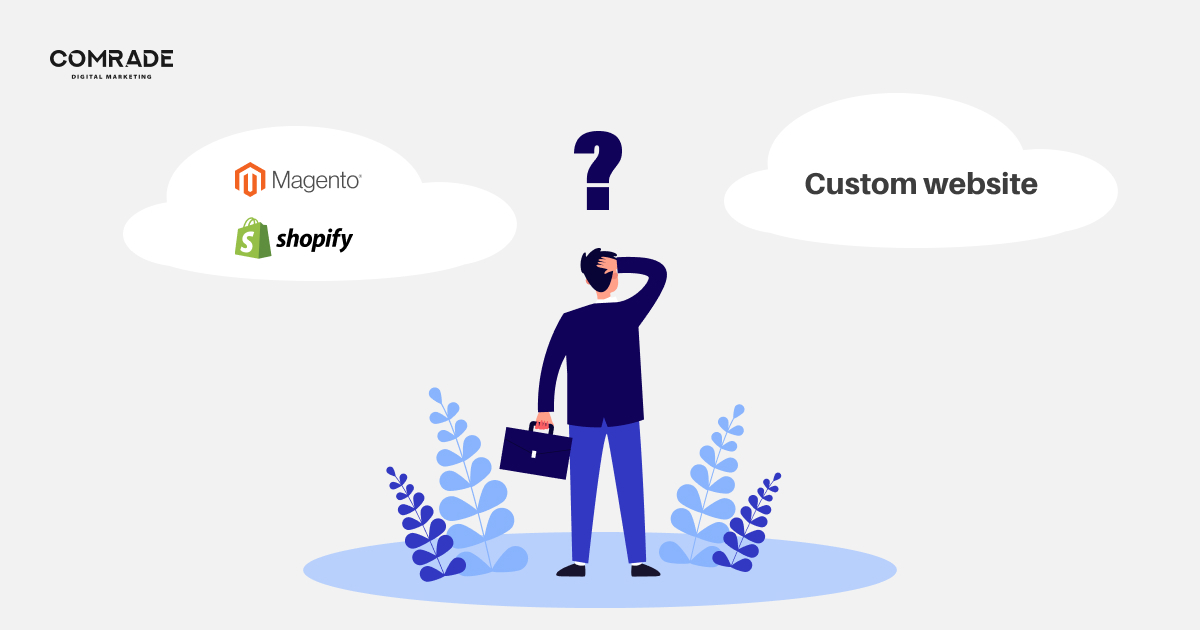When you build an eCommerce website from scratch, you need a modern tech stack to handle high traffic loads and a user-friendly interface with scalable eCommerce project architecture. A reliable web development vendor will provide both, with personal recommendations, depending on your business.
If you want to know how to build an eCommerce website from scratch, the first step is understanding your online business needs (as well as aspirations). The second is to hire talent who specialize in custom eCommerce website development. We’ve all heard farcical stories of consumers ordering products online, only to be amused and horrified by what they receive. The same goes for eCommerce website development for your online store; it pays to hire the best web development company you can find.
A user-friendly, technologically sound eCommerce website is the backbone to online store success. Building an eCommerce website from scratch is no small task, which is why it’s important to find a web development company that knows what they’re doing. In this blog, we’ll explore how to choose a platform and what features your software development vendor should include to ensure your new eCommerce website is a success.

3 Steps to Build an Ecommerce Website from Scratch
1. Choose a Platform for Your Online Store

eCommerce websites are built on marketplaces like Amazon, Etsy, or eBay, by website builders from scratch, or by using platforms like WooCommerce, Shopify, or Magento. Marketplaces offer immediate access to millions of visitors, but fierce competition, whereas having your own eCommerce website offers greater personalization but requires serious effort to drive traffic and sales.
Going to a Marketplace
Marketplaces offer immediate infrastructure and IT support. They are a lower investment compared to building an eCommerce website from scratch. Prominent marketplaces offer a massive customer base, albeit it’s highly competitive, and established search engine optimization for product category pages. Because they service thousands of eCommerce stores, marketplaces are constantly perfecting their offerings, and so both merchant and customer experiences are simple and, for the most part, seamless.
Creating a Custom Ecommerce Website
Building an eCommerce website from scratch allows for total control in design, layout, content, navigation, and functionality. One of the greatest advantages is direct access to your customers, leading to better customer services and increased upsell opportunities. While it’s never been easier to get a site up and running, there is still a load of technical steps like choosing a business and domain name and hosting service (for starters) that take time to implement. Not to mention, a strong digital marketing strategy is needed to get shoppers to your site.
2. Create a Proper Ecommerce Website Structure

No matter which method of website building you select, you must have a rock-solid website structure that permits users to find what they want in less than three clicks (this is the industry norm.) It should also help search engines understand and index your website efficiently, so it can rank on search engine results pages (SERPS).
A good website structure has some of the following characteristics:
- Proper categorization of products
- Mobile-friendly
- Links to popular products
- A clear search field
- Language options (if necessary)
- Calls to action to push people to sales pages
- Display shipping options
Technical Optimization for Your Online Business
Part of technical optimization when building eCommerce websites, apart from search engine optimization, is procuring proper security. While there are many eCommerce solutions for your business, you must be sure to pick a secure platform and web host for maximum protection. Not all platform security measures are equal or even the same. You’ll want to find a host and platform combination that offers protection against common malware and SQL injections.
Furthermore, you’ll need an SSL certificate. SSL stands for Secure Sockets Layer and is a digital certificate that authenticates a website’s identity and enables an encrypted connection. This connection keeps transactions secure and customer information safe and private. It’s mandatory under the Payment Card Industry (PCI) for all eCommerce websites to have one.
3. Add Important Features for Users
eCommerce feature integrations benefit both online stores and customers. Automation leaves less room for error, optimizing shipping fulfillment and increasing sales. Below are some basic key features your eCommerce site should have.
User Accounts
The convenience of multi-touchpoint access to personal shopping information is a major benefit e-commerce websites can offer online shoppers. Tying together all activities with a login makes it easier for online stores to deliver seamless transactions and personalized experiences. In fact, 65% of shoppers prefer checking out with customer accounts due to speed and convenience.
For eCommerce businesses, user accounts offer value in two ways. Firstly, it’s easier to track orders and integrate review and rewards programs features. Secondly, it enables eCommerce sites to better understand their target audience and personalize recommendations and communication, as well as retarget them if they’ve abandoned shopping carts.
Whether technical or relational, user accounts provide opportunities for many interactive experiences with shoppers. Furthermore, many eCommerce websites offer social sign-ins, allowing consumers to log into a third-party website using credentials from social networking sites or Gmail, rather than creating a new log-on specifically for that eCommerce site. It also makes for a frictionless sign-up process on mobile devices.
When an eCommerce store has the right data, it can tailor promotions to specific audience segments. For example, if you are running an online liquor store and find that women and men between 25 and 40 years from Chicago are the most active users on your eCommerce site, you can run two separate ad campaigns for each group. This way, you’re effectively optimizing your marketing budget and strategy.
Wishlist
According to Oberlo, “a wishlist allows shoppers to create personalized collections of products they want to buy and save them in their user account for future reference… Wishlists signify a customer’s interest in a product without an immediate intent to purchase.” They’re mutually beneficial for an e-commerce business and its consumers because they give customers a convenient way to remind themselves of a product while helping merchants measure product interest.
Wishlists drive sales, engagement, and retention, making them a powerful tool for any e-commerce business. Google cites that 40% of consumers believe their shopping experience would be better if retailers offered a wishlist for them to save items they’re interested in and can buy at a later stage. These prospects can potentially be engaged in drip marketing campaigns if customers opt-in for email notification.
Losing customers due to a lack of stock reflects poorly on eCommerce stores and is something wishlists solve with simple out-of-stock alerts via email or in-app notification. They’re also a great way to alert customers to sales, and pull them back into the marketing funnel, encouraging them to complete their purchases. Data gathered from wishlists can also be used in your marketing strategy to discern which items have a better chance of generating higher sales.
Some best practices for eCommerce business sites with wishlists include:
- Placing wishlist options in a visible place on product pages
- Easy and intuitive use when adding and removing items
- Confirmation an item has been added to a list
- Not forcing customers to signup just to add something to their wishlist
Shopping Carts

The primary purpose of an online shopping cart is to track and maintain all the products selected by the users to complete a purchase from an online business. It’s rare to come across e-commerce website builders who wouldn’t recommend this functionality, as it services the buying habits of the majority of consumers.
Shopping carts maintain and record all the products a buyer chooses to purchase from an online store. Well-designed eCommerce websites let consumers select products, modify their purchase options, and proceed further along the buyer journey. If you want to sell products easily and effectively in your online store, your website should integrate this eCommerce functionality.
Most eCommerce platforms like Shopify or WooCommerce offer their own carts, eliminating additional UI and web design costs if you’re building an online store on a budget. With their plug-and-play options, it’s possible to set up an entire store without coding knowledge or expertise. Just make sure that whatever platform you select is PCI-DSS compliant, meaning it meets Payment Card Industry Data Security Standards.
Additionally, there are two types of carts available for eCommerce websites; hosted shopping carts and licensed shopping carts. The first is provided by a third party who is responsible for maintenance and upgrades, while the second offers greater flexibility; however, the upfront costs are higher, and the eCommerce website development process requires hands-on expertise.
Order History
Like the title suggests, order history is the complete record of a customer’s orders. It includes shipping, delivery, and payment details. However, it’s not to be confused with “order status,” which shows an order’s processing stage, i.e., active, pending, processed, etc. An overview of a customer’s order history can help you personalize shopping experiences based on their purchases and potential needs, leading to higher customer lifetime value.
If you’re building an eCommerce website from scratch, you’ll want to integrate order management systems (OMS) which provide automation and integration across every step of the order journey. As an online store, you need to deliver consistent customer experiences at scale across every channel. With OMS systems, you can manage eCommerce store orders coming from multiple sales channels. A sound OMS will facilitate automation between service providers and aggregate data within a single interface.
Because retail data travels through multiple layers of sales channels, an eCommerce website requires a strong operational infrastructure. As more and more businesses in the eCommerce industry embrace multichannel retail, the need for order management systems has become essential. In fact, 62% of retailers, cite human error from manual process management as the root cause of inventory and fulfillment issues, which can easily be remedied with an OMS.
Payment Options
Although statistics vary, most consumers favor a purchasing process that allows them to pay via debit or credit card. Beyond that, there are e-Wallets, Cryptocurrencies, money transfers, and prepaid cards. The type of payment method you select will depend on whether you’re using an established eCommerce website platform provider or working with experienced web development specialists, as well as if your consumers make once-off or recurring payments.
Once-off Payments
Products or services purchased when needed fall under the once-off payment category. These are things like new appliances, large furniture items, or retail products purchased on an irregular basis. For these payments, more secure options are better, like Instant EFT, credit card, and e-wallets, for example.
Recurring Payments
Weekly meal kits, subscriptions, and rentals are classified as recurring payments. For these, it’s better to provide additional options less vulnerable to identity fraud, or credit cards reaching expiry dates. Direct debit payments tend to work best, and also decrease the chances of customers unfairly opting out of contracts or simply not paying.
Over and above payment options, you’d be wise to implement payment gateway technology. This authorizes the transfer of funds between buyers and sellers, essentially allowing your eCommerce website to request money from a customer’s bank for products or services they’ve purchased. Only once it’s approved, is the payment securely transferred to your bank, providing PCI compliance and a secured security layer against fraud.
Shipping
To customers, the shipping journey seems simple, but for merchants, to sell online is a little more complicated. Generally, eCommerce websites can manage inventory and order completion, assist with shipping labels and automate customer tracking and delivery emails with the support of plugins or custom eCommerce site extensions. However, this becomes more complex if there’s a fulfillment team, drop shippers, or large volumes of stock that need moving.
71% of shoppers expect cost-effective and fast delivery, and with the right partner, shipping can be affordable and efficient. From flat-rate to expedited, free and real-time carrier options, it can be challenging deciding which shipping strategy to use for your eCommerce website. A common shipping business model is to offer free shipping for orders that meet a minimum total, and a flat rate for orders under a specific price bracket.
For instance, you could offer a flat shipping rate for orders under $50, and free shipping for orders over $60, which encourages customers to add more to their cart, and boosts sales. You might also consider an innovative online sales approach that offers free shipping for a limited time as part of a larger online marketing strategy.
Calculating the shipping costs for each of your products will help determine the most effective shipping methods. Often, utilizing third-party shipping software offers value in negotiating better shipping rates with carriers, provides user-friendly interfaces and integrated automation that can help an eCommerce business communicate with customers throughout shipment tracking.
Reviews

Nearly 71% of online shoppers read between one and six customer reviews before making a purchasing decision. As of 2021, there are over 230 million US digital buyers, which is forecast to grow by at least 1% every year. Customer reviews have become integral in creating social proof. As entrepreneur Chris Anderson puts it: “Your brand isn’t what you say it is—it’s what Google says it is.”
And yet, the burden of choice for many consumers is overwhelming. Without reviews, they have no benchmark to help decide which product or service is best. For this reason, good eCommerce website builders always integrate review functions into an eCommerce platform. Having service or product reviews on your eCommerce site improve customer trust, loyalty, and brand credibility.
Whether you’re building your eCommerce website from scratch or going to a marketplace, you always want to make the review process easy for customers. Asking for a quick star rating out of five after delivery for your product as a whole, or asking for three or four ratings of different product and service features, provides valuable feedback for business growth. You can also give them the option to leave more detailed text reviews, should they desire to say more.
Another overlooked benefit of reviews is that they boost search engine optimization (SEO). When customers leave product or service reviews, they provide eCommerce websites with relevant and unique content that can be indexed and ranked by search engines. Hence, you should make sure your reviews are visibly displayed on your eCommerce website and on social media platforms to boost your profile. It’s worthwhile mentioning the global eCommerce site Shein which has an excellent review banner.

Get Help with Your Ecommerce Business
Building an online business takes ambition, time, expertise, and capital. Hopefully, this blog has provided valuable insight into how to build an eCommerce website from scratch. Like constructing a house, you want to start with a strong foundation that lets you scale as your business grows. As businessman Phil Crosby said: “It’s always cheaper to do it right the first time.”
At Comrade Digital Agency, our expert developers can build your eCommerce website from scratch; we also provide Magento development, WooCommerce development services and ecommerce SEO services that guarantee a higher ranking for your website. Our dynamic, engaging web solutions optimize buying processes and customer experiences for every type of site in every business sector. Recognized as a leading website developer and service provider, we guarantee the best results that will take your business to the next level. Why not contact us today to develop a high performance website that drives revenue?
Frequently Asked Questions
Can I build eCommerce website on my own?
The answer is yes, you can build your own eCommerce website. You need to follow these steps: choose a platform for your online store, create a proper eCommerce website structure, add important features for users.
How much does it cost to build an eCommerce website from scratch?
Website design setup fees can range from $1,500 - $30,000 in 2023, with eCommerce hosting costing $40 - $4000/month. You can easily overspend if you don't have a clear budget.
How long does it take to make an eCommerce website from scratch?
An example of a realistic timeline is as follows: Simple E-Commerce Website with up to 25 Products: 4 Weeks. Multiple categories and products on a semi-complex e-commerce website: 6 weeks. E-commerce website with complex features and custom design: 16 weeks.
In what cities do you operate?
Comrade originates in Chicago, but we worked all around the United States. We can help your business grow and increase revenue whenever you are. We have offices across most major cities in the US. For example, we can offer digital marketing services in Chicago or San Antonio. You can even find our internet marketing experts in Portland! If you want to know more about our Kansas City digital marketing agency or find out how exactly we can help you, contact us via the phone or email.


